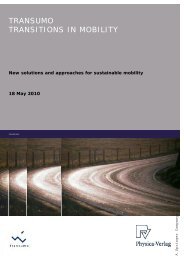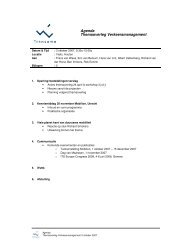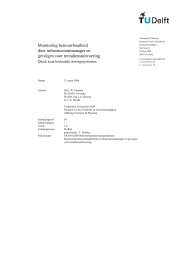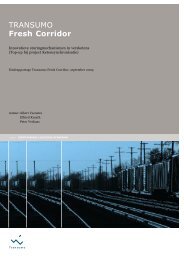Casestudie Breakdown prediction Contell PILOT - Transumo
Casestudie Breakdown prediction Contell PILOT - Transumo
Casestudie Breakdown prediction Contell PILOT - Transumo
You also want an ePaper? Increase the reach of your titles
YUMPU automatically turns print PDFs into web optimized ePapers that Google loves.
this example. Hence, nighttime data of this chosen dataset is free from external user<br />
influences.<br />
6.2.1 Detection of Changes in Behavior by Using Descriptive Statistics<br />
Section 5.10.1 introduced a promising way of recognizing changes in behavior by just<br />
comparing basic descriptive statistical measures. This section will now present<br />
calculated results for the selected dataset. As described in section 5.10.1, the<br />
suggested notification service compares succeeding daily daytime and nighttime<br />
values and reports irregular ones. This irregularity was defined as delta times the<br />
mean change. To obtain a better feeling for this delta, the calculated results are first<br />
of all presented in graphical form. Afterwards, two different deltas are chosen and<br />
their corresponding notifications are calculated. 80<br />
The following figures 6-3 to 6-10 contain the calculated results of daily day- and<br />
nighttime values of the promising basic measurements. 81 To allow an easy<br />
comparison of daytime and nighttime values, they are plotted with the same scale.<br />
The results of the also suggested whole day analysis are not pictured because they<br />
do not differ significantly from the daytime results.<br />
The daytime maximum values are very irregular. In fact, they are almost comparable<br />
to the general temperature overview. But eye-catching is a very low maximum value<br />
at the end of November. The nighttime values offer a much clearer overview of the<br />
system’s general behavior due to the missing of external user influences. But again,<br />
the graph contains the eye-catching low temperature. As this exceptional value is<br />
also recognizable at nighttime, it should be reported to a person in charge. A closer<br />
look at Figure 6-2 discovers a real change of cooling behavior within that time span<br />
of nearly two days, so that this notification should be done.<br />
Beside this exceptional value the maximum nighttime values are faced with another<br />
significant change at the beginning of January. Eye-catching is, furthermore, the<br />
behavior at the end of January. Within very few days, the daily nighttime maximums<br />
increased about half a degree and nearly remained on that level for the rest of the<br />
monitoring time. This significant step also indicates a change in cooling behavior and<br />
should be notified.<br />
80 See Table 6-2 for details<br />
81 See section 5.10.1 for details<br />
90
















